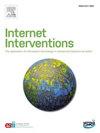社交焦虑症认知疗法的改变过程:面对面治疗与网络治疗形式的比较
IF 4.1
2区 医学
Q1 HEALTH CARE SCIENCES & SERVICES
Internet Interventions-The Application of Information Technology in Mental and Behavioural Health
Pub Date : 2024-11-02
DOI:10.1016/j.invent.2024.100786
引用次数: 0
摘要
背景与疗效研究相比,调查心理治疗变化过程的研究很少见,尤其是基于互联网的干预。目的 研究社交焦虑症在线治疗师指导的认知疗法干预(iCT-SAD)的候选变化过程,并将结果与相应的面对面疗法(CT-SAD)进行比较。方法 使用多层次结构方程模型分析随机对照试验(n = 99)的数据,将过程变量的时间优先性纳入其中,并对预测因素的受试者内和受试者间成分进行分解。这些模型考察了三个候选变化过程:自我关注、消极社会认知和抑郁情绪。结果在 CT-SAD 和 iCT-SAD 中,负性社会认知和自我关注被认为是临床改善的重要中介因素。两者的效应强度相似,且未观察到调节中介效应。还有证据表明,社交焦虑症状与这些过程变量之间存在周期性关系。在 CT-SAD 中,抑郁情绪也是一个显著但微弱的中介因素,但在 iCT-SAD 中却不是。结论:在线治疗与面对面治疗显示出相似的变化过程模式,自我关注和消极社交认知对两种治疗方法的临床改善都有中介作用。因此,针对这些因素提高SAD干预疗效和效率的努力可能同样适用于在线和面对面干预。本文章由计算机程序翻译,如有差异,请以英文原文为准。
Change processes in cognitive therapy for social anxiety disorder: A comparison of face-to-face and internet-based treatment formats
Background
Compared to efficacy research, studies investigating the processes of change in psychological therapy are rare, especially for internet-based interventions. While many online therapies are based on face-to-face therapy protocols, it is unknown whether the processes of clinical improvement differ between these treatment formats.
Objective
To examine candidate change processes in an online therapist-guided cognitive therapy intervention for social anxiety disorder (iCT-SAD), and compare the results to the corresponding face-to-face therapy (CT-SAD).
Methods
Data from a randomised controlled trial (n = 99) were analysed using Multilevel Structural Equation Models, incorporating the temporal precedence of the process variable, and disaggregating the within- and between-subject components of the predictors. These examined three candidate change processes: self-focused attention, negative social cognitions, and depressed mood. Moderated mediation models provided an additional test of the moderating effect of treatment format.
Results
Negative social cognitions and self-focused attention were supported as significant mediators of clinical improvement in both CT-SAD and iCT-SAD. Effects were of similar strength and moderated mediation was not observed. There was also evidence of cyclical relationships between social anxiety symptoms and these process variables. Depressed mood also emerged as a significant but weak mediator in CT-SAD, but not in iCT-SAD. Moderated mediation was not observed.
Conclusion
The online format of therapy showed a similar pattern of change processes to face-to-face treatment, with self-focused attention and negative social cognitions mediating clinical improvement in both treatments. Efforts to improve the efficacy and efficiency of SAD interventions by targeting these factors may therefore be equally applicable to online and face-to-face interventions.
求助全文
通过发布文献求助,成功后即可免费获取论文全文。
去求助
来源期刊

Internet Interventions-The Application of Information Technology in Mental and Behavioural Health
Medicine-Health Informatics
CiteScore
6.50
自引率
9.30%
发文量
94
审稿时长
6 weeks
期刊介绍:
Official Journal of the European Society for Research on Internet Interventions (ESRII) and the International Society for Research on Internet Interventions (ISRII).
The aim of Internet Interventions is to publish scientific, peer-reviewed, high-impact research on Internet interventions and related areas.
Internet Interventions welcomes papers on the following subjects:
• Intervention studies targeting the promotion of mental health and featuring the Internet and/or technologies using the Internet as an underlying technology, e.g. computers, smartphone devices, tablets, sensors
• Implementation and dissemination of Internet interventions
• Integration of Internet interventions into existing systems of care
• Descriptions of development and deployment infrastructures
• Internet intervention methodology and theory papers
• Internet-based epidemiology
• Descriptions of new Internet-based technologies and experiments with clinical applications
• Economics of internet interventions (cost-effectiveness)
• Health care policy and Internet interventions
• The role of culture in Internet intervention
• Internet psychometrics
• Ethical issues pertaining to Internet interventions and measurements
• Human-computer interaction and usability research with clinical implications
• Systematic reviews and meta-analysis on Internet interventions
 求助内容:
求助内容: 应助结果提醒方式:
应助结果提醒方式:


